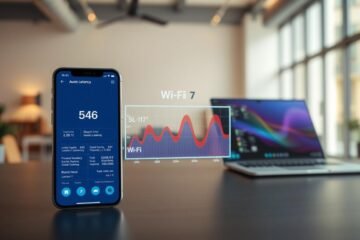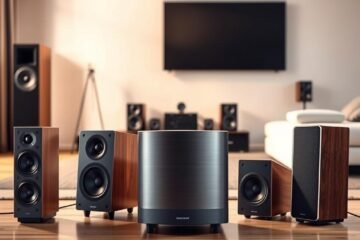In a world full of distractions—whether it’s the buzz of office chatter, the hum of airplane engines, or the roar of city traffic—Active Noise Cancelling (ANC) headphones have become essential for staying focused and enjoying crystal-clear sound. But when it comes to choosing between Over-Ear vs. In-Ear ANC Headphones, many people find themselves stuck.
Both offer powerful noise cancellation and impressive sound quality, but they serve different needs and lifestyles. In this article, we’ll break down the five key differences that matter most—so you can decide which type of ANC headphone truly fits you best.
Today, you can choose from two main types: circumaural (around the ear) and in-canal. Each type has its own way of blocking out noise, aiming to create a quiet space in loud places.
The bigger models use a mix of internal and external microphones. They’re great at blocking out deep sounds like airplane engines or air conditioners.
On the other hand, the smaller earbuds use external microphones only. They’re easier to carry but might not block sudden noises as well.
What you choose depends on your lifestyle, comfort, and where you listen. Knowing the differences will help you pick the best for your daily listening needs.
Key Takeaways
- Noise cancellation can reduce ambient sound by up to 45 decibels, creating a significantly quieter listening environment
- Larger models use hybrid technology with both internal and external microphones for superior low-frequency noise reduction
- Compact earbuds typically employ feedforward technology that works best with consistent background noise
- Your choice between styles should consider your specific lifestyle needs and listening environments
- Both designs serve the same purpose but differ in their technical approach to sound isolation
- The global market for noise-canceling audio devices exceeded $20 billion in 2022
The Evolution of Noise Cancellation Technology
Noise cancellation technology has changed a lot. It started as big headsets for pilots and now we have sleek, powerful audio solutions. This shows how engineering can make technology better and more accessible.
Big steps in miniaturization, signal processing, and battery tech have helped a lot. These changes made the tech smaller and better at blocking out noise. Now, we get great audio quality and noise reduction.
From Bulky Headsets to Compact Solutions
The first noise-cancelling headphones came out in the 1950s for pilots. They were big and heavy. They helped pilots talk clearly in loud cockpits.
In the 1980s, Bose made the first noise-cancelling headsets for pilots. These were big and expensive. They were mainly for professionals and audio fans.
The big change came in the early 2000s. Engineers made the tech smaller. They created smaller mics, better processors, and batteries that lasted longer. This made the tech fit into smaller designs without losing quality.
| Era | Form Factor | Primary Users | Battery Life | Noise Reduction |
|---|---|---|---|---|
| 1950s-1980s | Large aviation headsets | Pilots | External power | Basic |
| 1990s-2000s | Bulky consumer headphones | Travelers, audiophiles | 8-10 hours | Moderate |
| 2010s | Streamlined over-ear designs | Mainstream consumers | 20+ hours | Advanced |
| Present day | Compact in-ear & over-ear options | General public | 30+ hours (over-ear), 5-10 hours (in-ear) | Sophisticated |
Today, we have two main types of noise cancellation. Over-ear headphones block out a lot of noise and last a long time. In-ear models are small but also block out a lot of noise. This lets people pick what works best for them.
The Growing Popularity of ANC in Consumer Audio
More people want noise cancellation because of travel and work. Long flights and noisy workspaces make it hard to focus. This need for quiet has grown a lot.
Smartphones also helped make ANC popular. People wanted better sound quality for their music. Noise cancellation became a key feature to improve listening in noisy places.
The COVID-19 pandemic made noise cancellation even more important. Working from home meant needing quiet spaces for calls and focus. This made noise cancellation a must-have, not just a luxury.
“The evolution of noise cancellation technology represents one of the most significant advancements in consumer audio over the past decade, transforming from a niche feature to a fundamental aspect of the premium headphone experience.”
Now, every big audio company offers ANC headphones at different prices. This technology is a big difference-maker in high-end headphones. Companies keep making it better for both noise reduction and sound quality.
This change has led to a market where we can choose between over-ear and in-ear ANC. Each type works differently, with its own benefits and drawbacks. We’ll look at these in the next sections.
For frequent flyers and commuters, see our Top 7 Best Noise-Cancelling Headphones for Travel 2025 to discover the models built for long-haul comfort and quiet journeys.
Understanding Active Noise Cancellation
Modern headphones use a cool tech called active noise cancellation. This feature changes how we enjoy music, podcasts, and calls in noisy places. Unlike regular headphones, active noise-cancelling headphones actively block out unwanted sounds before they hit your ears.
When you look for top-notch headphones or earbuds, ANC is often a big deal. But what makes it so unique? And how does it differ from regular headphones? Let’s explore the science behind the silence.
What is ANC and How Does It Work?
Active Noise Cancellation (ANC) uses smart electronics to cut down on background sounds. It’s like creating a quiet bubble around your ears. Unlike regular noise isolation, ANC works in a more advanced way.
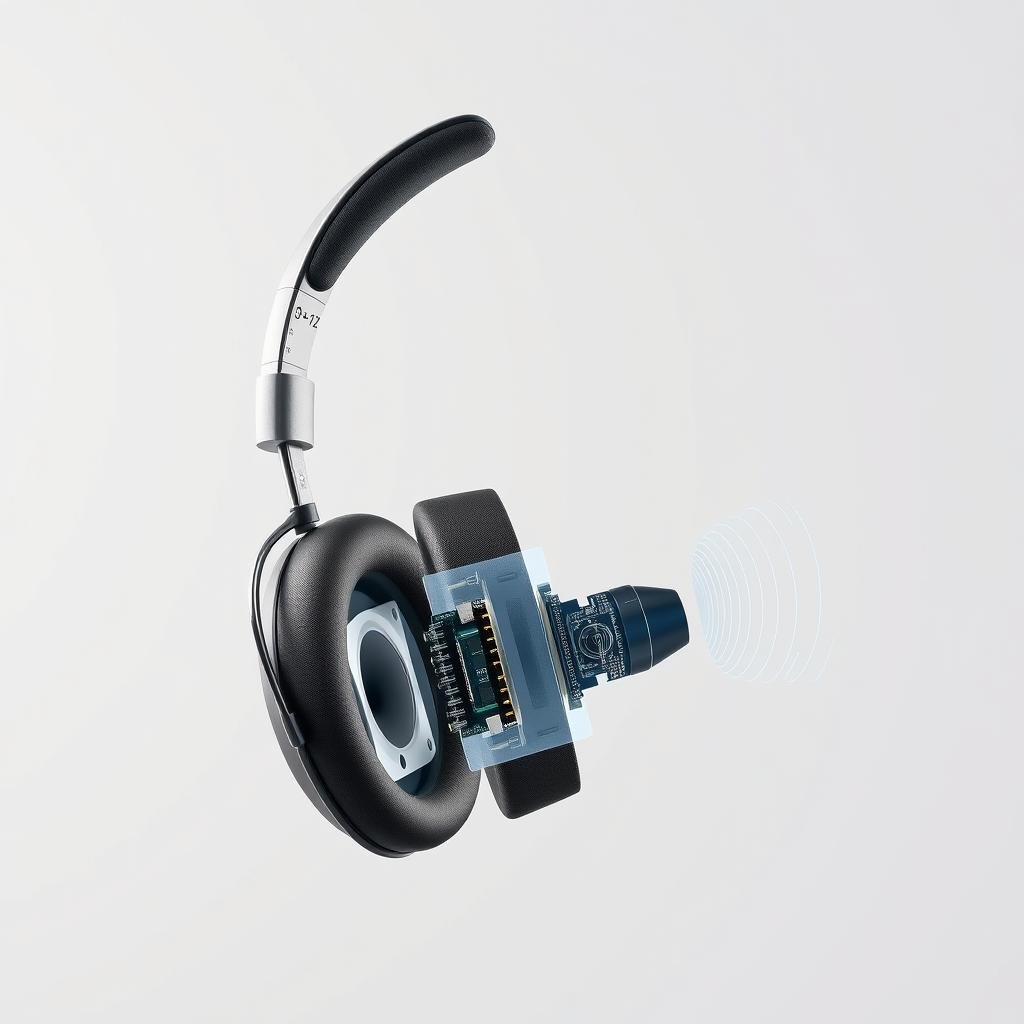
The magic happens through a physics trick called destructive interference. Here’s how it works:
- Small microphones on your headphones pick up ambient noise around you
- A built-in processor analyzes these sound waves
- The processor makes an inverse sound wave (anti-noise) that’s opposite to the noise
- When these opposite sound waves meet, they cancel each other out
- You get much less background noise as a result
Think of ocean waves: when a crest meets a trough of equal height, they cancel each other, making a flat surface. ANC works the same way with sound waves. It’s great at reducing constant, low-frequency sounds like airplane engines, air conditioners, or traffic noise.
Many top headphones use both active and passive noise reduction. The physical design helps block sound with sound isolation. The electronic ANC system then tackles any noise that gets through.
Types of Noise Cancellation Technology
Not all ANC systems are the same. The tech has evolved into different types, each with its own strengths for different listening needs and headphone designs.
| ANC Type | How It Works | Best For | Typical Applications | Limitations |
|---|---|---|---|---|
| Feedforward ANC | Uses external microphones to detect noise before it reaches your ear | High-frequency noise reduction | In-ear earbuds, compact designs | Less effective for sudden noises |
| Feedback ANC | Uses internal microphones inside the ear cup to detect noise that passes through | Low-frequency noise reduction | Entry-level over-ear headphones | Limited frequency range coverage |
| Hybrid ANC | Combines both feedforward and feedback microphones | Comprehensive noise reduction across frequencies | Premium over-ear headphones | More expensive, higher power consumption |
| Adaptive ANC | Automatically adjusts noise cancellation levels based on environment | Variable environments (commuting, office, travel) | High-end models of both types | Requires sophisticated processing power |
Over-ear headphones usually have hybrid ANC systems because they’re bigger. This lets them use more microphones and processing, making them better at canceling out a wide range of sounds.
In-ear models often use feedforward ANC because they’re smaller. This method is more limited, but modern earbuds are getting really good at noise cancellation, even though they’re tiny. Some high-end earbuds now have bits of hybrid systems, thanks to better miniaturization.
Knowing these differences helps explain why some headphones work better in certain places. For example, over-ear models with hybrid ANC are great for constant noise like airplanes. But, small earbuds might be better for everyday use, even if they don’t cancel noise as much.
Benefits of Active Noise Cancellation
Active noise cancellation does more than just block out noise. It improves your listening experience and overall health. As ANC technology has grown, so have its benefits. Knowing these can help you decide if ANC headphones are right for you.
Enhanced Listening Experience
ANC changes how you hear music. It removes background noise, making music details clearer. You can hear the subtleties in music that were lost before.
One of the biggest advantages is listening at lower volumes. Without background noise, you don’t need to turn up the music. This keeps the sound quality high and protects your hearing.
The type of ANC device affects how you enjoy these benefits. Over-ear headphones block out more noise because they cover your ears. In-ear models are great for those who are always on the move because they’re small and effective.
Health and Wellness Advantages
ANC does more than just improve sound quality. It also boosts your health. Studies show that constant noise can raise stress, lower brain function, and harm your heart.
- Less listening fatigue – Your brain works less hard to ignore noise
- Lower stress levels – A quieter audio space even in loud places
- Better focus and concentration – Fewer distractions mean you can work better
- Improved sleep quality – Some ANC headphones are made for sleep
For those in noisy workspaces or who travel a lot, ANC is a big help. It lets you focus without getting tired from ignoring distractions. Many people say they feel less tired after using ANC headphones in loud places.
When looking at ANC prices, think about the health benefits too. Basic ANC headphones start at $100, while top models can cost over $400. Over-ear headphones block more noise but cost more and are less portable.
Investing in good ANC technology is worth it for better sound and hearing health. Think about how ANC fits into your life and listening habits when choosing.
Over-Ear ANC Headphones: A Complete Look
Over-ear ANC headphones are known for their top-notch sound and comfort. They have big ear cups and advanced tech. This makes them a favorite among those who love good sound.
These headphones cover your ears with soft ear cups. This helps block out noise before the tech kicks in. Let’s dive into what makes them special and if they’re right for you.
Design and Technology Features
Over-ear headphones have a unique design. They have big ear cups that fit your ears well. This design helps block out noise.
The headband is key for comfort and durability. Premium models often have memory foam padding and strong materials. This makes them comfortable to wear for a long time.
These headphones are big for a reason. They can have better tech inside. This includes:
- Larger driver units for better sound
- More microphones for better noise cancellation
- Bigger batteries for longer playtime
- Advanced touch controls
- Special processors for noise analysis
High-end models can connect to multiple devices at once. They also have a mode to let you hear your surroundings. This is great for talking or staying safe.
The ear cups help ANC work better. They block out noise, including low sounds like planes or air conditioners.
Pros and Cons of Over-Ear Models
Over-ear headphones have good points and some downsides. Knowing these can help you decide if they’re right for you.
Here are the benefits:
- Superior comfort for long listening – They spread pressure evenly and don’t touch your ears
- Great noise cancellation, even for low sounds
- Better sound quality with a wider soundstage
- Long battery life (20-30+ hours)
- Good passive noise isolation even without ANC
But, there are also some downsides:
- They’re bigger, making them less portable
- They’re harder to carry around
- They might get hot on your ears
- They cost more than in-ear options
- They might cause “headphone hair” or get in the way of earrings and glasses
Comfort and fit vary between models and head shapes. Most good ones have adjustable headbands and rotating ear cups. The pressure they put on your head also varies.
| Feature | Entry-Level | Mid-Range | Premium |
|---|---|---|---|
| Ear Cup Material | Synthetic leather | Protein leather | Memory foam with velour or leather |
| Battery Life | 15-20 hours | 20-30 hours | 30-40+ hours |
| ANC Performance | Basic (mainly low frequencies) | Moderate (low and mid frequencies) | Advanced (full spectrum) |
| Additional Features | Basic controls | Touch controls, app support | Multipoint, wear detection, EQ customization |
| Average Weight | 250-300g | 220-270g | 200-250g |
Over-ear headphones are great for comfort and sound. They’re perfect for office, home, flights, and long listening sessions. Their noise isolation is top-notch.
When choosing, look at weight, clamping force, and ear cup size. This ensures they’re comfy for your listening time. Many find the cost worth it for better sound and comfort.
In-Ear ANC Earbuds: The Complete Picture
In-ear ANC earbuds are small but powerful. They offer a unique way to cancel noise while being easy to carry. These devices pack advanced sound technology into a size that fits in your pocket. As people want to cancel noise on the go, makers are pushing what’s possible in these small systems.
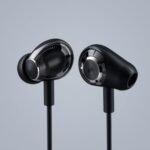
Design and Technology Features
In-ear ANC earbuds are a marvel of engineering. They are smaller than over-ear headphones but cancel noise just as well. They use a stem or concha-fitting design to fit all the parts in a tiny space.
The key to these earbuds is their microphone array. These tiny mics pick up outside noise. The internal processor then makes sound waves that cancel it out. Top models use both outside and inside mics for better noise cancellation.
Eartip design is key for comfort and blocking out noise. There are different types:
- Silicone tips – Durable and easy to clean, good at blocking noise
- Memory foam tips – Fit your ear canal well, block noise better
- Hybrid tips – Mix silicone and foam for comfort and noise blockage
Driver technology in these earbuds has improved a lot. While many use traditional drivers, the best ones use balanced armature drivers or hybrids. This lets them deliver greatsound qualitydespite their small size.
Power management is another challenge. These earbuds need to be small but have enough battery life. Most have a charging case that extends their use time while keeping them light and comfy.
Pros and Cons of In-Ear Models
In-ear ANC earbuds have many benefits:
- Exceptional portability – They’re easy to carry anywhere
- Discreet appearance – They’re less noticeable than over-ear headphones
- Secure fit for activity – They stay in place during exercise
- Convenience – They’re quick to put on and take off
- Weather resistance – Many are protected against sweat and rain
But, there are some downsides to consider:
- Comfort constraints – They might be uncomfortable for long use
- Battery limitations – They usually last 5-8 hours per charge (but cases extend this)
- Sound quality ceiling – Their size limits bass and soundstage
- Fit dependency – Good fit is key for sound and noise cancellation
- Easier to lose – Their small size makes them easy to misplace
Thesound qualityof in-ear ANC earbuds has gotten much better. They face size limits, but top models now offer great sound. Bass is a challenge, but new tech helps improve it.
Finding the right fit is key for comfort and sound. A bad fit can ruin both passive and active noise cancellation. Many apps now help find the best fit for your ears.
In-ear ANC earbuds are great for those who want to carry noise-cancelling tech easily. Their tech keeps getting better, closing the gap with bigger headphones while keeping their size and flexibility.
Over-Ear vs In-Ear ANC Headphones: 5 Key Differences
Over-ear and in-ear ANC headphones have their own strengths and weaknesses. They differ in five key areas that affect your listening experience. Knowing these differences helps you choose the right headphones for your needs, not just based on trends.
Comfort and Fit
Headphones comfort comparison shows over-ear and in-ear models have different approaches. Over-ear headphones use cushioned pads that spread pressure evenly. This makes them more comfortable for long listening times.
In-ear models, on the other hand, use silicone or foam tips that fit inside your ear canal. While they can be comfy, they might cause ear fatigue after hours of use.
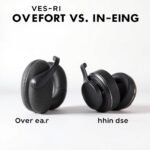
Your ear shape and head size affect which style feels better. People with bigger ears or glasses might prefer in-ear models. Over-ear headphones can be uncomfortable where glasses meet the head.
- Over-ear: Better for long listening sessions, distributes pressure evenly
- In-ear: More secure fit for movement, but may cause fatigue faster
- Personal anatomy: Ear size, head shape, and glasses all affect comfort
Sound Quality and Audio Performance
The sound quality over-ear vs in-ear comparison highlights big differences. Over-ear headphones have bigger drivers, leading to stronger bass and a wider soundstage.
This bigger sound chamber in over-ear models creates a more immersive sound experience. It’s great for music genres like classical and jazz, where sound quality matters a lot.
In-ear headphones, despite their smaller size, can deliver impressive bass and noise isolation. Thanks to new driver technologies, even premium in-ear models now offer clear and detailed sound.
| Audio Aspect | Over-Ear Advantage | In-Ear Advantage |
|---|---|---|
| Bass Response | Fuller, more natural | Tight, can be powerful with good seal |
| Soundstage | Wider, more spacious | More intimate, “in your head” |
| Detail Retrieval | Better instrument separation | Can excel at vocal clarity |
| Noise Isolation | Good passive isolation | Superior canal seal isolation |
Battery Life and Charging Capabilities
When looking at which is better over-ear or in-ear headphones, battery life is a key difference. Over-ear headphones usually last 20-40 hours on a single charge, even with ANC on.
This long battery life comes from the bigger space for batteries in the ear cups. For those who travel a lot or don’t like charging often, this is a big plus.
In-ear models generally last 5-10 hours on a charge. But, most come with charging cases that add extra power. A fully charged case can give you 2-4 full recharges, extending your listening time to 15-30 hours.
- Over-ear: 20-40 hours continuous playback
- In-ear: 5-10 hours per charge plus 2-4 additional charges from case
- Quick-charge: Many models offer 1-5 hours of playback from just 10-15 minutes of charging
Charging methods also vary. Over-ear headphones often use USB-C, while in-ear models may support wireless charging. This makes earbuds more convenient for quick top-ups on the go.
Portability and Everyday Usability
Portability is a clear difference between these headphones. In-ear models are super lightweight and come with small charging cases. They’re easy to carry in a pocket or bag without bulk.
Over-ear headphones, while foldable, take up more space. They come with cases that protect the headbands and ear cups but add bulk. For those with limited space or who like to pack light, this is important.
Deploying and storing headphones quickly is also a factor. In-ear models are almost instant to use—just pop them out of the case. Over-ear headphones need more effort to adjust and fit right.
For active users, in-ear models are more stable during exercise. They often have water and sweat resistance ratings (IPX4-IPX7) for workouts. Over-ear headphones can get hot and uncomfortable during physical activity.
Price vs. Value Proposition
The final consideration is the value proposition at different price points. Premium over-ear ANC headphones cost $300-$400, while top in-ear models are $200-$300.
This price gap reflects the extra materials, bigger drivers, and longer battery life of over-ear designs. But, there are mid-range options ($100-$200) in both categories with varying features and compromises.
Value depends on how long you plan to use the headphones and if you can repair them. Over-ear headphones can have replaceable ear pads and batteries, extending their life. In-ear models, like true wireless earbuds, have sealed designs with batteries that degrade over time and can’t be replaced.
Your listening habits should guide your choice. Over-ear models might be worth the extra cost for home listening and travel. For casual, on-the-go use, in-ear models offer better value for money.
If affordability is your top concern, check out our Top Budget Noise-Cancelling Headphones Under $100 (2025) for options that deliver solid ANC without breaking the bank.
Which Style Suits Your Lifestyle?
The right ANC headphone style depends on your daily activities, comfort, and where you listen. Over-ear and in-ear models differ a lot. But, your lifestyle often makes the choice clear. Let’s see how to pick the perfect headphone for you.
Decision Chart: Finding Your Perfect Match
Choosing between over-ear and in-ear ANC headphones is easier when you know what you need. This decision chart will help you find the best fit for your lifestyle.
| Priority Factor | Choose Over-Ear If You… | Choose In-Ear If You… |
|---|---|---|
| Daily Usage | Use headphones mainly in stationary settings | Need audio all day while active |
| Comfort Needs | Like cushioned comfort for long use | Don’t like ear pressure and heat |
| Sound Preference | Want soundstage and bass | Prefer clarity and convenience |
| Environment | Work in quiet places or need full isolation | Move around in busy places and need portability |
Think about your answers to these questions carefully. Many people find they need different headphones for different situations. You might even want to own both styles if your life is busy!
Best Choices for Commuters and Travelers
For those always on the move, the right ANC headphones can change your travel game. Commuters and travelers face special challenges like changing environments and limited space.
In-ear ANC earbuds are great for daily commuters. Models like the Sony WF-1000XM4 and Apple AirPods Pro are super portable and block out noise well. Their small charging cases fit easily in pockets or bags, and they charge quickly for long use.
For long trips, over-ear headphones are often the top choice for travel. The Bose 700 and Sony WH-1000XM5 block out airplane noise and last long on battery. Many also come with airplane adapters and fold up for easy travel.
When comparing brands for travel, Sony and Bose usually come out on top. Apple and Sennheiser are close behind. Look for models that are comfortable at high altitudes.
Curious about advanced noise-blocking tech? Explore our Top Hybrid ANC Headphones for Work and Travel in 2025 to see how hybrid systems balance active and passive cancellation.
Ideal Options for Office and Work-From-Home
The office environment has its own needs for ANC headphones, whether you’re in an office or working from home. Good call quality, all-day comfort, and awareness of your surroundings are key.
For office workers, over-ear ANC headphones like the Jabra Evolve2 85 and Microsoft Surface Headphones 2 have clear microphones for calls and block out office noise. They often have mute buttons and pause when removed.
For those working from home, in-ear options offer more freedom. The Jabra Elite 85t and Samsung Galaxy Buds Pro let you move around while staying connected. They also have transparency modes for quick household checks without removing your earbuds.
Both styles have models with multipoint connectivity, which is great for professionals. This feature lets you switch between devices easily without re-pairing.
When picking office headphones, think about how visible you want them to be and if you’ll need to switch between tasks often. The right choice will boost your productivity and keep you professional.
Top Over-Ear ANC Headphones in 2023
In 2023, over-ear ANC headphones come in many styles and prices. You can find affordable options and high-end models with advanced features. This variety helps meet different needs and budgets.
When looking for over-ear ANC headphones, knowing the price range is key. Premium models offer top-notch tech and comfort. Budget options provide good performance without costing too much.
Premium Selections
The high-end over-ear ANC headphone market ($300-400) features several top brands. These models showcase the latest in noise cancellation, sound quality, and comfort.
Sony’s WH-1000XM5 ($399) leads with its noise cancellation and 30-hour battery. It also has a new design for better comfort and clear calls in noise.
Bose’s Noise Cancelling Headphones 700 ($379) have a sleek design and 11 levels of noise cancellation. Their adaptive microphone system helps keep calls clear in noisy places.
Apple’s AirPods Max ($549) bring spatial audio to over-ear headphones. They are more expensive but offer great build quality and integration with Apple devices.
Sennheiser’s Momentum 4 Wireless ($349) combines great sound with 60-hour battery life. Their noise cancellation adjusts to your surroundings, making them versatile.
| Premium Model | Price | Battery Life | Standout Feature |
|---|---|---|---|
| Sony WH-1000XM5 | $399 | 30 hours | Best-in-class ANC |
| Bose NCH 700 | $379 | 20 hours | Superior call quality |
| Apple AirPods Max | $549 | 20 hours | Spatial audio |
| Sennheiser Momentum 4 | $349 | 60 hours | Extended battery life |
Budget-Friendly Options
You don’t have to spend a lot to get good noise cancellation. The $100-200 range offers great value with essential features.
Anker’s Soundcore Life Q30 ($80) is a top value pick. It has effective noise cancellation, customizable EQ, and 40-hour battery life. It’s not as built as premium models but offers great comfort and performance.
Audio-Technica’s ATH-ANC700BT ($199) offers balanced sound and solid noise cancellation at a lower price. It lacks some features of premium models but is a good mid-range choice.
JBL’s Tune 760NC ($129) has reliable noise cancellation and JBL’s signature bass sound. It has 35 hours of battery life and a foldable design, making it great for travelers.
The Sennheiser HD 450BT ($199) gives you a taste of Sennheiser’s sound quality at a lower price. It doesn’t have as strong noise cancellation as premium models but offers good sound quality and 30-hour battery life.
| Budget Model | Price | Battery Life | Best For |
|---|---|---|---|
| Anker Soundcore Life Q30 | $80 | 40 hours | Best value |
| Audio-Technica ATH-ANC700BT | $199 | 25 hours | Balanced sound |
| JBL Tune 760NC | $129 | 35 hours | Bass lovers |
| Sennheiser HD 450BT | $199 | 30 hours | Audio quality |
Comparing budget and premium options shows differences in noise cancellation, build quality, and features. Premium models often have adaptive ANC and better sound quality. Budget options have simpler features but are more affordable.
Sound quality improves with price, but the gap has narrowed. Budget models focus on pleasing sound profiles, while premium options aim for accurate sound with customization options.
Whether you’re looking at budget or premium options, today’s over-ear ANC headphones can greatly enhance your listening experience. They block out unwanted noise and deliver immersive audio.
Best In-Ear ANC Earbuds on the Market
Finding the perfect in-ear ANC earbuds is a journey through many options. Prices range from $50 to over $300. Each model offers something special, whether it’s top-notch noise cancellation, sound quality, or battery life.
Two key things to look for are wireless connectivity and durability. The best earbuds have strong Bluetooth connections and can handle daily wear and tear. Let’s look at the top picks in both the high-end and budget categories.
High-End Performance Models
Premium in-ear ANC earbuds in the $200-300+ range offer amazing performance. These models show what’s possible in such small devices.
The Bose QuietComfort Ultra earbuds lead in noise cancellation. They block constant low rumbles and sudden high sounds. They also have Bluetooth 5.3 for easy pairing with two devices at once.
Sony’s WF-1000XM5 earbuds are great for sound quality and noise cancellation. They support high-resolution audio with LDAC. They’re also water-resistant, but not as much as some others.
Apple’s AirPods Pro 2 are perfect for iPhone users. They pair instantly and switch devices easily. They have immersive sound and are water-resistant, but not fully.
For Android users, the Samsung Galaxy Buds Pro 2 are a great choice. They last up to 8 hours with ANC on. They’re also very water-resistant, making them great for workouts.
| Model | ANC Performance | Battery Life (ANC on) | Durability Rating | Connectivity Features |
|---|---|---|---|---|
| Bose QuietComfort Ultra | Exceptional | 6 hours (24 with case) | IPX4 | Bluetooth 5.3, multipoint |
| Sony WF-1000XM5 | Excellent | 8 hours (24 with case) | IPX4 | Bluetooth 5.3, LDAC codec |
| Apple AirPods Pro 2 | Very Good | 6 hours (30 with case) | IPX4 | H2 chip, instant pairing |
| Samsung Galaxy Buds Pro 2 | Very Good | 8 hours (30 with case) | IPX7 | Auto device switching |
Everyone’s needs differ. Our Best ANC Headphones for Your Lifestyle – 2025 Guide matches headphone styles with work, fitness, and everyday listening routines.
Affordable Quality Choices
The $50-150 range has surprisingly good ANC earbuds. They make smart choices to keep costs down while delivering solid performance.
Anker Soundcore Liberty Air 2 Pro earbuds offer great ANC at a low price. They can’t block all noise, but they reduce most sounds well. They have Bluetooth 5.0 for a stable connection, but no multipoint.
Jabra Elite 4 Active earbuds focus on durability with an IP57 rating. They’re great for athletes and have good ANC. Their battery life is also impressive, lasting 7 hours (28 with the case).
For those on a tight budget, the JLab Epic Air ANC earbuds are a good choice. They have a “Be Aware” mode and long battery life. They’re not as durable or effective as pricier models, but they’re a great value.
The EarFun Air Pro 2 earbuds offer a good balance. They have 6-hour battery life, IPX5 water resistance, and effective ANC. They also have Bluetooth 5.2 for low latency gaming and videos.
“Budget ANC earbuds have improved a lot. They can’t match the best models, but the best affordable ones offer 80% of the experience at 30-40% of the cost.”
When choosing affordable ANC earbuds, think about what you need most. If battery life is key, go for the JLab Epic Air ANC. For durability, the Jabra Elite 4 Active is the best. For the best noise cancellation, the Anker Soundcore Liberty Air 2 Pro is your best bet.
- Best overall value: Anker Soundcore Liberty Air 2 Pro
- Best for battery life: JLab Epic Air ANC
- Best for durability: Jabra Elite 4 Active
- Best under $100: EarFun Air Pro 2
These affordable options make ANC technology more accessible. They may not be as refined as the top models, but they offer great performance for everyday use.
Conclusion
The perfect headphones for you depend on what matters most in your listening experience. We’ve explored how over-ear and in-ear ANC options excel in different areas.
Over-ear headphones offer superior sound quality with rich bass and detailed audio. Their larger drivers create a more immersive soundstage. They also have longer battery life, so you can enjoy music for longer without needing to recharge.
In-ear models are the clear winner when it comes to portability. They’re small and easy to carry, making them perfect for travel, exercise, and on-the-go use. Many users like how discreet they are in public and how easily they fit in a pocket or small bag.
Your lifestyle should guide your decision. If you listen at home or during long flights, over-ear headphones might be better. But if you’re always on the move, in-ear buds are more convenient.
Many audio enthusiasts choose both styles. They use over-ears at home and in-ears when commuting or exercising. This way, they get the best of both worlds.
As ANC technology improves, the difference between these two types will likely shrink. Manufacturers are working to make sound quality better in smaller sizes. They’re also making over-ear options lighter and more comfortable.
Whichever style you choose, today’s ANC headphones offer great control over your audio environment. They change how you experience music, podcasts, and calls in our noisy world.
Looking for something beyond traditional ANC? The 10 Best Bone Conduction Headphones 2025 for Runners & Cyclists showcase open-ear alternatives for safety and comfort during workouts.

